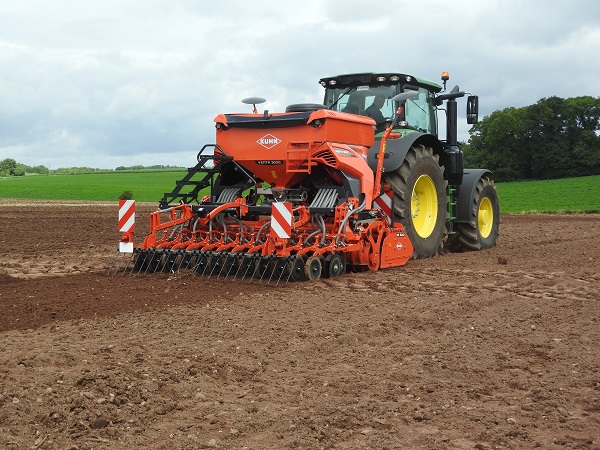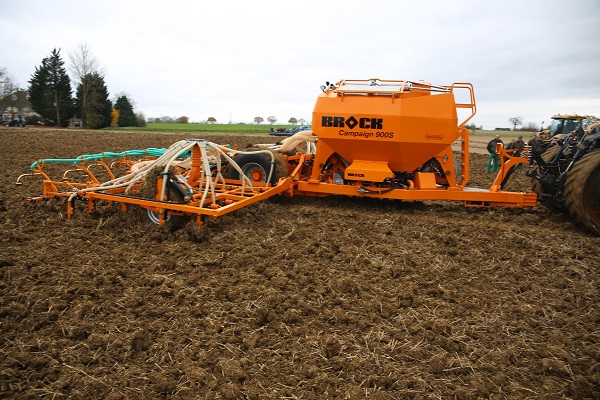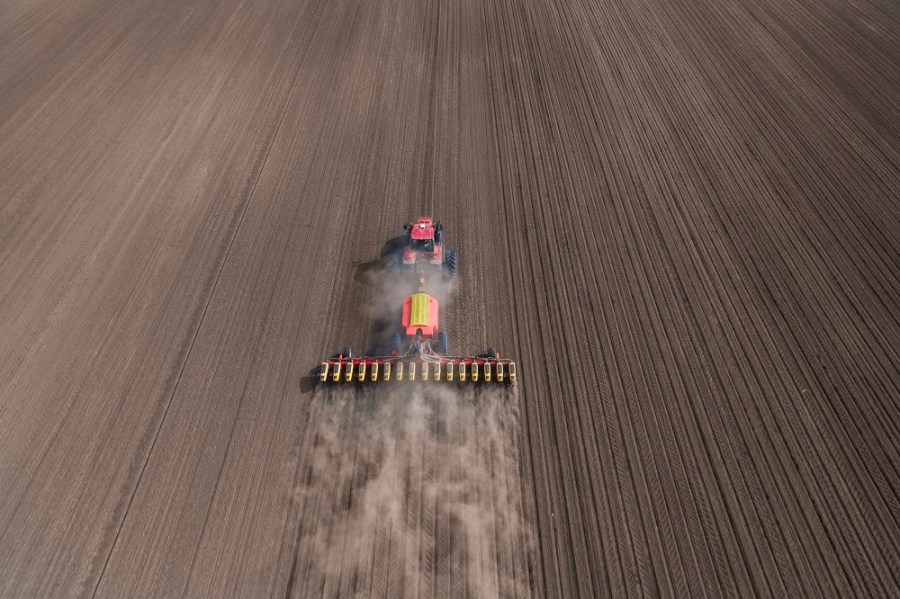More growers than ever are set to get the drill out this spring. CPM takes a look at some of the latest market offerings.
Pin-pointing which machine is likely to be best equipped for individual circumstances is not always straightforward.
By David Jones
Each of the major seed drill manufacturers goes about the business of improving accuracy, speeding the process and enhancing build quality in different ways.
Between them, they provide for all conditions, soils and seed types, but for the grower, pin-pointing which machine is likely to be best equipped for individual circumstances is not always straightforward.
Kuhn
The “all-new, next generation combination seed drill” is how the company introduces its 4m Venta 4030 + HR 4040 set-up. The power harrow element has straight blades and a Duplex gearbox that allows the rotor speed to be adjusted to suit changing soil conditions.
The drill itself has an1800-litre seed hopper incorporating a fluted metering unit – with large splines for larger seeds – wheat, barley, peas and beans, for example – and smaller ones for small seed crops like oilseed rape and alfalfa. Rates can be set from the cab at any level between one and 430kg/ha.
The Venta has a speed-sensing radar facility to give precise seeding at up to 15km/h, with the option of shutting off every other row for bespoke applications. The Seedflex precision coulter bar system is in charge of seed placement, while the wide, offset, parallel-mounted double discs combine speed of operation with accurate seed placement.
Kuhn has also expanded its range of Espro trailed min-till drills by adding new 6m 6000RC and 4m 4000RC models. Both are foldable and, in contrast with previous versions, can now place the seed and apply fertiliser in a single pass.
The first Espro drills arrived on the market nearly three years ago since which time, the company reports, they’ve been well received, particularly by medium to large-scale farmers and contractors who appreciate the combination of low power requirement with high capacity.

The Venta has a speed-sensing radar facility to give precise seeding at up to 15km/h.
Brock
Initially available in its largest format, the new Campaign drill range is spearheaded by the 900S, with its working width of 13.4m This will be joined by subsequent models down to 8m. This introductory version features a large capacity hydraulic fan that diverts to provide an integrated blowdown of the tank and all operational areas.
This facility includes air routing through the machine’s chassis to all seed, fertiliser and micro-granular units. Pipework conveying seed and fertiliser is kept free of condensation by a diesel-powered chassis heater, while all electric control units and cabling are fully enclosed.
Operating depth settings on individual wheels are easily adjusted using a simple and secure pin system, with each wheel designed to run on uncultivated ground aided by integral wheel scrapers and at least two tines running behind.
In terms of the design and specification of this first Campaign drill, the company the says that particular attention was paid to four principle aspects of its operation: to make it more adaptable to changing conditions, to simplify the job of the operator, to provide greater stability when in transport mode and – perhaps most significantly – to widen the operational weather window.

The 13.4m Campaign drill will be joined by subsequent models down to 8m.
Väderstad
In the near future – June, to be exact – a new Väderstad machine, the Tempo L18 precision drill will begin to roll off the Swedish production line. With 18 rows at spacings of 500 or 508mm, the Tempo has been designed principally for the OSR and sugar beet sectors.
However, it’ll also have the capability to be adjusted down to 12 rows and the spacing configured at between 700 and 800mm in order to accommodate crops like maize and sunflower. The L 18 will extend the Tempo range beyond the existing L12 and L16 versions.
A 5000-litre hopper can be specified, with the fertiliser metered via the high capacity Fenix III system, which can handle up to 350kg/ha at 15km/h. The application rate can be adapted to match a range of field conditions by using a variable rate system, even at higher speeds.
Depth control is achieved by hydraulic wing pressure, shifting weight from the machine’s inner section to the outer wings and enabling the Tempo L to react to field unevenness and produce uniform crop emergence.
And, to enable the machine’s transport wheels to follow the row spacing, it has a telescopic wheel axle that can be adjusted from the cab. This feature means that the transport wheels can always run between the seed rows, then simply re-set to the transport width of 3m.
Vaderstad’s latest piece of drill technology is SeedEye, a new seed counter and seed flow coulter blockage monitor designed to simplify the calibration process. It works once the operator has set an accurate seed rate using the iPad display on the cab control panel – any deviation from the pre-set deviation parameters is alerted by an alarm sounding, with a red light on the display identifying the faulty coulter.
Claydon
The patented Opti-Till concept is central to Claydon’s drill design and operation, and features prominently in its Hybrid M mounted models. The system gets to work when the leading tine breaks the soil – to the optimum degree – in order to create a moist, aerated tilth likely to encourage rapid germination.
In so doing, a drainage channel is created in order to avoid the build-up of water and the rotting of the seed, promoting strong root establishment by tapping into the moisture in the undisturbed banks. The end result, Claydon explains, is improved structure and fertility, whatever the soil type.
Five Hybrid M models are in production, ranging between 3m and 6m, with the smallest available in a ‘with fertiliser’ format, and users can expect to cover between 20-40ha a day, dependent on which version is being used.
Opti-Till also forms the basis of the Claydon Hybrid T trailed seed drills which, based on the operating width, can get through up to 60ha in an average day, broadening their appeal to larger-scale growers and contractors.
Amazone
Introduced at the Agritechnica event a few months ago, the Centaya Super pneumatic combination seed drill comes with two hopper options – 1600 or 2000-litres – positioned well forward on the machine to maintain an overall centre of gravity close to the tractor.
Beneath the hopper, an electrically driven metering unit is equipped with a choice of metering cassettes for when seed types need to be changed quickly. The operator has a choice of being able to adjust the seed rate via the terminal in the cab, or to be controlled via application maps. In addition, calibration can be achieved at the press of a button, while pre-metering in field corners is also possible under this system.
Amazone has clearly spent time in the quest of precision seed placement with the Centaya and has come up with a choice – either TwinTec double disc or RoTeC single disc coulters at row spacings of 12.5cm or 15cm, with a coulter pressure of up 60kg per coulter. Pressure adjustment can be achieved either mechanically, via the SmartCentre control facility, or hydraulically from the cab. The latter method allows the operator to react to changing soil types while on the move.
Another Amazone newcomer is the AD-P 01 Special, a pneumatic, harrow-mounted seed drill which has a 3m working width and can be employed in combination with one of three additional new items of kit – the KE 01 rotary harrow and either the KX 01 or KG 01 rotary cultivators.
The drill can also be supplied with a segmented distributor head which, depending on the row spacing, provides the option to control 2 x 5 or 2 x 6 tramline segments. When creating tramlines, the electric metering system reduces the seed rate, depending on the number of closed rows.
Stanhay
The ProAir precision drill is the first new product from Stanhay for seven years. The name was at one time almost synonymous with the precision drill sector but the intervening period has been spent, the company says, working on a fundamental re-design of its products, resulting initially in the ProAir.
This new arrival is 40% lighter and 30% shorter than the model that preceded it, the Star Plus. The ProAir provides growers with a compact and durable precision drill that Stanhay states is easy to set up and offers a higher degree of adjustability than any other unit on the market. It incorporates Stanhay’s award-winning metering unit and a new infinite depth control, measurable to 0.1mm accuracy, by means of a mechanical counter.
A sealed, maintenance-free flexible drive shaft provides slip-free drive from the lay shaft to the metering unit – proven on maize drills, but a first for the vegetable sector. Other enhancements include a 6m horizontal folding frame and a vacuum seed emptier fitted as standard.
Pöttinger
Growers of maize could well be interested in the Aerosem PCS Duplex Seed drill, which the Austrian manufacturer says has the potential to boost crop yields by up to 10%. Working output is also increased by a higher driving speed. The secret lies in the Duplex Seed drilling process – the maize can be planted alongside a companion crop, or switched to cereals.
Trials have demonstrated that the drill delivers an increase in performance of close to 25% because of a higher driving speed – up to 10km/h – together with a work rate boost of close to 2ha/hr working with four double rows to a width of 3m. In addition, the company says, the degree of precision seed placement is enhanced because the metering system is running at half the normal speed.
Three Aerosem models are being made available with the Duplex Seed configuration – the 3002, which leaves no untilled surface, the 3502 (12.5cm untilled left and right) and the 4002 (12.5cm overlap, left and right).
Farmet
The Czech implement manufacturer has introduced two new drills recently – the Falcon Pro Tandem and the Impact Precision seeder. The Falcon is a strip seeder with a tandem design that allows the seed to be drilled along with parallel placement of fertiliser in the root zone. Front and rear tyre rollers provide precise depth guidance with accurate working depth adjustment of the seeding discs.
The Impact precision drill is designed for wider-row crops, such as OSR, maize and sunflower and, again, can apply fertiliser at the same time. The manufacturer stresses the advanced nature of the seeding units here, pointing to specially positioned sensors that scan each individual seed to identify gaps or doubles.
Working and output information on the Impact is displayed on the cab-mounted ISOBUS terminal where all machine functions can be monitored constantly by the operator, with desired adjustments made on the move to take account of soil conditions.
Horsch
A reduced incidence of resistant blackgrass is claimed when using Horsch’s new Avatar SD direct drill – available in either 3m or 4m working widths – due to its low level of seedbed disturbance. This is achieved by sowing with the single disc coulter, which helps to prevent the blackgrass from germinating.
Nevertheless, coulter pressure of up to 310kg ensures the soil is penetrated, which, in combination with a strong coulter frame, means that the coulter maintains the set sowing depth – even when working on uneven seedbeds. The following press wheel closes the seeded furrow and consolidates the row.
The Avatar’s hopper and metering components are the same as those proven on Horsch’s Pronto DC seed drills, although the 2800-litre hopper can be substituted for a double hopper version. A standard ISOBUS terminal manages the machine’s control and monitoring functions.




